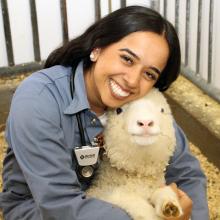I’m about six weeks into my externship and at this point, I feel like I’m a character in Grey’s Anatomy. From emergencies to complicated surgeries, it seems as if I’ve seen and dealt with just about everything imaginable. With that being said, the highlight of my time here has definitely been the surgeries, whether it’s a neuter or an anterior cruciate ligament (ACL) repair, I’m always pumped to scrub in and get my hands dirty. If I had to do a rough tally, I’ve led about 60 surgeries (spays and neuters only) and assisted with 25 miscellaneous surgeries, which has been more than anything I’d ever imagined I’d do. As I’ve been ploughing through three to four surgeries a day, the importance of my actions while I have a patient open on the table has been repeatedly reinforced. I have made it a point to be on my ‘A game’ while in surgery, which entails knowing what surgical instruments to use, practicing gentle handling of tissues, using my anatomic knowledge and carrying out proper suturing technique.

 I’ve spent the past three years practicing and perfecting my surgery skills on DASIE’s (models we can use to practice suture skills) and silicone models in clinical skills labs – trying different suture patterns and simply getting into the rhythm of throwing down knots. My dad even went the extra mile to help me improve my surgical technique as he let me suture the Thanksgiving turkey closed after he had stuffed it. When third year rolled around, we had the opportunity to start completing spays and neuters on patients. Although all that practice helped, completing multiple surgeries in a small frame of time hadn’t compared to anything I had done before. At OVC, our spay and neuter surgeries consisted of two students doing the surgery and one student who took responsibility for anesthesia. During these past few weeks, I have been accountable for doing the surgery as well as keeping an eye on the anesthesia. Of course, Dr. Gordzelik has always been around and I always had a veterinary technician with me, but I felt the weight of my responsibility to the patient. I’m eternally grateful to Dr. G for allowing me to operate on as many patients as I have because in the real world, veterinarians juggle both operating and anesthesia on a daily basis.
I’ve spent the past three years practicing and perfecting my surgery skills on DASIE’s (models we can use to practice suture skills) and silicone models in clinical skills labs – trying different suture patterns and simply getting into the rhythm of throwing down knots. My dad even went the extra mile to help me improve my surgical technique as he let me suture the Thanksgiving turkey closed after he had stuffed it. When third year rolled around, we had the opportunity to start completing spays and neuters on patients. Although all that practice helped, completing multiple surgeries in a small frame of time hadn’t compared to anything I had done before. At OVC, our spay and neuter surgeries consisted of two students doing the surgery and one student who took responsibility for anesthesia. During these past few weeks, I have been accountable for doing the surgery as well as keeping an eye on the anesthesia. Of course, Dr. Gordzelik has always been around and I always had a veterinary technician with me, but I felt the weight of my responsibility to the patient. I’m eternally grateful to Dr. G for allowing me to operate on as many patients as I have because in the real world, veterinarians juggle both operating and anesthesia on a daily basis.
Many of us have watched an array of surgeries on TV and have been intrigued by the issues that medicine can treat and resolve. And although shows like Grey’s Anatomy are addicting and fascinating, here are some things that you may not have thought about:
- Anesthesia is as important as the surgery itself. Anesthesia requires you to monitor heart rate, respiratory rate, temperature, blood pressure, oxygen saturation level, jaw tone and reflexes. All these parameters indicate the “anesthetic depth” of a patient, which needs to be managed appropriately. There is an optimal anesthetic plane, you want the patient to be in.
- There are different suture types and patterns that are used according to what the surgery entails. For example, when tissue has a lot of tension, you can put down a “surgeon’s throw”, which is an extra loop that allows for better knot security.
- Sometimes tissue is considered to be very friable meaning that it tears or sloughs off easily. This makes surgery particularly hard because if you over-handle friable tissue, it will tear off as you’re working on it.
- This one might be more obvious, but all surgeries require intense concentration – especially if you’re just starting out. I’m usually mentally exhausted after surgery and need my lunch break to recuperate because a few hours of intense concentration wears me down.
